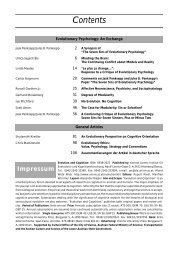Contents - Konrad Lorenz Institute
Contents - Konrad Lorenz Institute
Contents - Konrad Lorenz Institute
You also want an ePaper? Increase the reach of your titles
YUMPU automatically turns print PDFs into web optimized ePapers that Google loves.
Of Brains and Minds<br />
signs of localized anatomical specialization above<br />
and beyond specific sensory and motor connections,<br />
and their polymodal interactions.<br />
Although adaptation of an organism to its environment<br />
is the chief process directing biological<br />
evolution, with the evolution of intelligence organisms<br />
became more and more independent of their<br />
environments, by modifying the environments according<br />
to their needs. This process culminated in<br />
the evolution of mankind, which can be understood<br />
only as a result of the interaction of two kinds<br />
of evolution, the biological and the cultural (AYALA<br />
1986). Such considerations have led various authors<br />
to argue that the human brain can acquire a large<br />
variety of epigenetically derived functions via interactions<br />
of a limited number of evolutionary conserved<br />
affective/motivational systems (situated<br />
largely in subcortical areas) with a set of plastic general-purpose<br />
learning mechanisms in the cerebral<br />
cortex (see PANKSEPP/PANKSEPP 2000; PANKSEPP et al.<br />
2002). It does not mean that there are no specialpurpose<br />
learning systems in the brain, such as fear<br />
learning, but the human cerebral cortex includes<br />
much more than a conglomeration of special-purpose<br />
learning mechanisms. It contains a neural architectecture<br />
that can generate flexible features<br />
which may be best conceptualized as rewritable.<br />
Cultural evolution, however, being the emergent<br />
result of the evolution of mind, cannot dispense<br />
with biological preconditions; it builds on biological<br />
facts and faculties (VOLLMER 1984; WUKETITS<br />
1986). Though cultural evolution indeed presupposes<br />
biological evolution it is not fully explicable<br />
in terms of theories and methods of the latter, or as<br />
WUKETITS (1986, p199) puts it: “Cultural evolution…<br />
has transgressed organic evolution and<br />
shows a certain autonomy’. The special status of cultural<br />
heredity can be derived from the fact that most<br />
cultural innovations are devised precisely in order<br />
to meet the environmental challenges or to improve<br />
our models of reality, whereas biological evolution<br />
has a mindless, random character. It is appropriate<br />
therefore, to distinguish adaptations to the environment<br />
due to cultural selection from those that take<br />
place by the selection of genotypes. Cultural inheritance,<br />
furthermore, is an infinitely faster process<br />
than genetic inheritance, since it is based on the<br />
transmission of information through direct communication,<br />
and through books, the arts and the<br />
media, which makes that a new scientific discovery<br />
or technical achievement can be transmitted to the<br />
whole of mankind in less than one generation (AY-<br />
ALA 1986).<br />
Human Language and Intelligence<br />
It is evident that the role of human language in the<br />
transmission of knowledge is extremely important,<br />
even so prominent and pervasive that it is hardly<br />
possible to estimate human general intellectual capacity<br />
independent of linguistic capacity (MACPHAIL<br />
1982). lts manifestations and, in particular, that of<br />
its newly acquired functions—description and argumentation—is<br />
the most peculiar phenomenon in<br />
human problem solving. While animals can communicate<br />
by expressing their inner state by means<br />
of their behavior, and by signaling to conspecifics,<br />
(e.g., in case of danger), man is the only creature<br />
that is able to make true and false statements, and to<br />
produce valid and invalid arguments (see POPPER<br />
1968; POPPER/ECCLES 1977).<br />
The progressive accumulation of interactions between<br />
environment (both physical and social),<br />
‘conserved’ subcortical systems and the ‘generalpurpose”<br />
cerebral cortex gave rise to a qualitatively<br />
different shade of mind—one that could communicate<br />
not merely with signs, but in symbolic terms.<br />
On the other hand, we have seen that a language<br />
system—of the type found in humans—is not essential<br />
for consciousness. It is plausible that organisms<br />
who do not possess an sophisticated language system,<br />
are aware of the external world. This is not to<br />
say, however, that language does not enrich consciousness<br />
or that it does not contribute to our<br />
model of reality.<br />
If we assume that part of the basis of human<br />
speech is inherited in the DNA, and that language<br />
is as much a biological as a cultural adaptation,<br />
then changes in the brain that permit the advantageous<br />
supplement of language acquisition to perception<br />
and communication would have had obvious<br />
selective advantages throughout the period of<br />
hominid evolution (DEACON 1998). We may conceive<br />
human language, therefore, as a superorganic<br />
form of adaptation, evolved not only as a cognitive<br />
adaptation contributing to the knowledge of reality<br />
of each individual, but also as a means of sharing<br />
and, even more importantly, influencing states<br />
of mind among conspecifics. Indeed, because of<br />
language, human beings are not only able to construct<br />
individual representations of the external<br />
world, but they can also contribute to and learn<br />
from collective models of reality, that is, the cumulative<br />
experience of the whole of mankind. With<br />
its cognitive and linguistic skills Homo sapiens tries<br />
to know its world and even exerts itself to the utmost<br />
to control it.<br />
Evolution and Cognition ❘ 185 ❘ 2003, Vol. 9, No. 2








